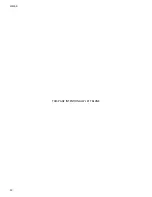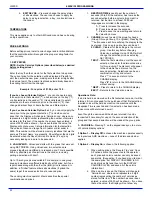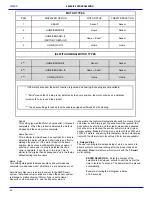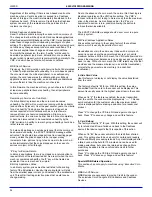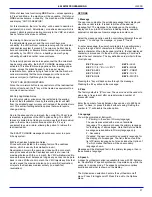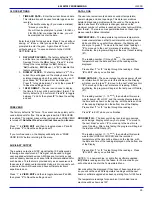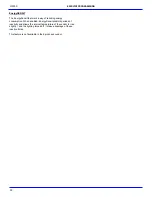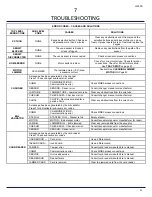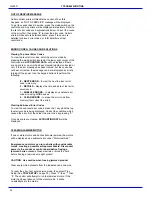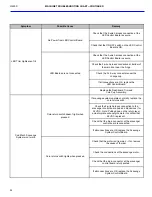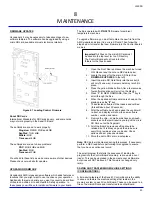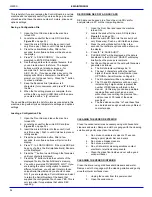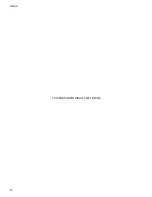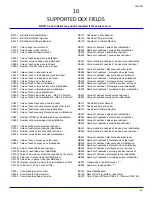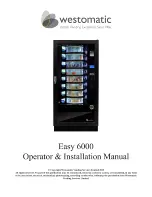
L0190D
26
Regardless of this setting, if there is cash-based credit on the
machine when a Card is inserted (or swiped) in a Cashless
device of this type, the credit is immediately transferred to the
Cashless Account. (If there is more Credit than the Cashless
system can accept, the remainder will be paid back to the
customer as change.)
Bill and Cash-Less Applications:
Sensit 3 software allows running the vendor with no coin mech.
The changes to allow bill-only and bill and cashless applications
affect fundamental MDB behavior of the VMC. It was decided to
make these changes without introducing new layers of option
settings. The typical customer using a coin-based system should
not notice any changes except under unusual conditions. This
section will explain those changes and unusual conditions.
To simplify the discussion, the term “healthy” will be used to
describe a peripheral (coin mech, bill validator, or a cashless
device) which is present, which is communicating normally to the
VMC, and which has no fatal out-of-service conditions.
MDB Out-of-Service:
Previously, the VMC would go out-of-service if what it determined
a “critical” peripheral became unhealthy. In a coin-based system,
the coin mech was the critical peripheral. In a cashless-only
system, the card reader was the critical peripheral. Bill-only
applications were not supported, so an unhealthy validator was
never sufficient to take the machine out-of-service.
In this firmware, the machine will only go out-of-service if at first
at least one peripheral becomes healthy, then all peripherals
become unhealthy.
Remaining in Service w/o Coin Mech:
If a bill validator is present, and the coin mech becomes
unhealthy, the VMC will now continue running with the validator
(and cashless if present). Over the past several years, the criteria
for an “unhealthy” finding have become more stringent, as
various reported error conditions such as coin jams were
removed from out-of-service consideration. Right now, in
practical terms, the coin mech either has to burn out completely
or become disconnected to be considered unhealthy by the
VMC’s criteria. A healthy coin mech going unhealthy should be a
rather rare occurrence.
To help notify patrons and service personnel that the coin mech
has become unhealthy, the EXACT CHANGE message will be
activated. This should discourage patrons from inserting paper
money, unless the prices happen to be in paper money
increments. Also, patrons trying to feed coins into the mech will
notice immediately that the coins disappear (in the case of a
serious coin jam) or fall through.
“#” Key for Escrow Return
In bill-only applications, there is no classic coin return button to
request return of the last-inserted bill. As a result, when the coin
mech is considered unhealthy, the “#” key will be treated as
equivalent to a coin mech escrow return.
Bill-Only Application Notes:
In a bill-only system, prices must be restricted to the scaling
factor of the bill validator. Usually, this scaling factor will start
from the smallest paper currency unit instead of the smallest coin
unit. This will limit setting selection prices that would require
change-making.
Due to the absence of a coin mech, the normal No Cheat logic is
disabled, regardless of the VMC option setting. The VMC’s
fairness is limited to not taking in more money than the maximum
price in the machine. As mentioned earlier, the ‘#’ key is
equivalent to escrow return, possibly allowing the patron to
retrieve the last-inserted bill.
The EXACT CHANGE message should never occur in a pure
bill-only system.
Bill Plus Cashless Application Notes:
Prices will be restricted to the scaling factor of the cashless
device, which is usually the smallest coin unit.
Revaluation occurs in the same way it does with a coin mech,
except in cases where the payment medium is at or near its
maximum balance. With a coin mech, the VMC will allow credit to
exceed the maximum balance as long as any excess can be paid
back in coins. Without a coin mech, the VMC rejects any bills that
would exceed the maximum balance (in a card-first revaluation)
or rejects the payment medium entirely (in a cash-first
revaluation).
8. Hide Card Value
Use this feature to display or not display the value transferred
from the card.
The factory default is “
N
” for no. With this setting, the value
transmitted from the card to the vendor will be displayed. This
amount is usually equal to the highest priced item in the vendor.
When set to “
Y
” the feature is enabled, the value transmitted
from the card to the vendor will be displayed as “-.- -”. This can
avoid confusion for the customer when the maximum priced
value is displayed before making a selection for a lesser cost
product.
Press “8” to change the YES to a NO and again to change it
back. Press “#” to save any change and exit this feature.
9. Card Refund
The factory default is “
Y
” for yes. With this setting, the vendor will
try to refund credit from a failed vend back to the Cashless
device if that device reports that it is capable of this action.
When set to “
N
”, the vendor will retain the credit from a failed
vend. This setting should be used only for certain card readers
that have difficulty processing refunds. Any credit displayed after
a failed vend will be held for 15 minutes and can be used for
making selections, but cannot be returned as change. More
credit may be added to this
un-refundable
credit for other
purchases.
Press “9” to change the YES to a NO and again to change it
back. Press “#” to save any change and exit this feature.
Special MDB-Related Operation
This section does not apply to machines using ‘Executive’ Coin
Mechs.
MDB Out-Of-Service:
MDB Devices are necessary to provide Credit to the vendor.
These include Coin Changers, Bill Validators and Cashless
Devices.
6
SERVICE
PROGRAMMING
Summary of Contents for EPIC SENSIT 3
Page 12: ...L0190D 6 THIS PAGE INTENTIONALY LEFT BLANK ...
Page 18: ...L0190D 12 THIS PAGE INTENTIONALLY LEFT BLANK ...
Page 26: ...L0190D 20 THIS PAGE INTENTIONALLY LEFT BLANK ...
Page 44: ...L0190D 38 THIS PAGE INTENTIONALLY LEFT BLANK ...
Page 46: ...L0190D 40 THIS PAGE INTENTIONALLY LEFT BLANK ...
Page 50: ...L0190D 44 THIS PAGE INTENTIONALLY LEFT BLANK ...
Page 52: ...L0190D 46 THIS PAGE INTENTIONALLY LEFT BLANK ...









